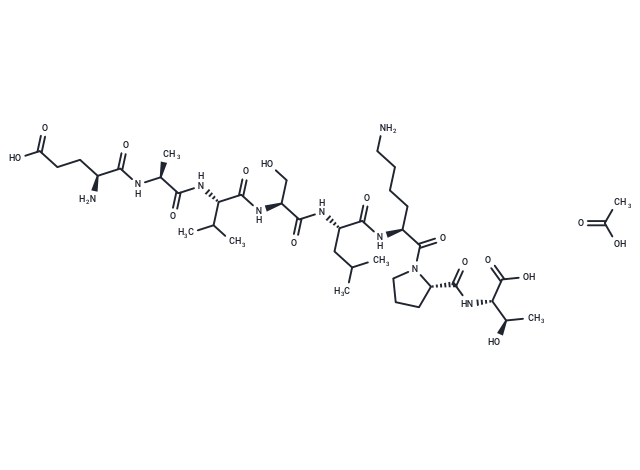Shopping Cart
- Remove All
 Your shopping cart is currently empty
Your shopping cart is currently empty

PKCε Inhibitor Peptide acetate is a selective PKCε inhibitor containing the site for its specific receptor for activated C kinase (RACK). PKCε Inhibitor Peptide acetate inhibits the translocation of PKCε, but not α-, β-, and δPKC.

| Pack Size | Price | Availability | Quantity |
|---|---|---|---|
| 1 mg | 56 € | In Stock | |
| 2 mg | 81 € | In Stock | |
| 5 mg | 112 € | In Stock | |
| 10 mg | 186 € | In Stock | |
| 25 mg | 314 € | In Stock | |
| 50 mg | 452 € | In Stock | |
| 100 mg | 620 € | In Stock | |
| 200 mg | 835 € | In Stock |
| Description | PKCε Inhibitor Peptide acetate is a selective PKCε inhibitor containing the site for its specific receptor for activated C kinase (RACK). PKCε Inhibitor Peptide acetate inhibits the translocation of PKCε, but not α-, β-, and δPKC. |
| In vitro | PKCε Inhibitor Peptide acetate(1 µM; 24 hours) significantly inhibits Oleic acid-induced connexin 43 Ser368 phosphorylation and prevents Oleic acid-induced gap junction disassembly in cardiomyocytes[1]. |
| In vivo | In C57BL/6J mice transplanted the hearts of FVB mice, PKCε Inhibitor Peptide acetate (20 mg/kg/day; osmotic pumps s.c.) significantly improved the beating score throughout the treatment. PKCε Inhibitor Peptide acetate treatment almost abolished the rise in pro-fibrotic cytokine, TGF-β, and monocyte recruiting chemokine MCP-1 levels. PKCε Inhibitor Peptide acetate reduced the infiltration of macrophages and T cells into the cardiac grafts and decreased parenchymal fibrosis[2]. |
| Alias | PKCε Inhibitor Peptide acetate(182683-50-7 Free base) |
| Molecular Weight | 904.02 |
| Formula | C39H69N9O15 |
| Smiles | C[C@@H](O)[C@H](NC([C@@H]1CCCN1C([C@@H](NC([C@@H](NC([C@@H](NC([C@@H](NC([C@@H](NC([C@@H](N)CCC(O)=O)=O)C)=O)C(C)C)=O)CO)=O)CC(C)C)=O)CCCCN)=O)=O)C(O)=O.CC(O)=O |
| Storage | store at low temperature,keep away from moisture | Powder: -20°C for 3 years | In solvent: -80°C for 1 year | Shipping with blue ice. |

Copyright © 2015-2025 TargetMol Chemicals Inc. All Rights Reserved.